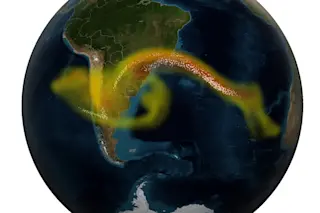The way Earth scientists can be very odd when seen from the outside. It is common to hear us say things like "oh, it was only a million years ago". Most people never consider events that happened a million years ago. Sometimes considering what you had for lunch makes yesterday seem like a long time ago. This is all about perspective and the question we ask of time.
Space is Big
Astronomers have faced a similar issue to distance. Douglas Adams, famed science fiction author, may have put it best when he wrote this description of the size of space in the Hitch Hiker's Guide to Galaxy:
Space is big. You won't believe how vastly, mind-boggling big it is. I mean, you might think it is a long way down the road to the chemist's, but that's just peanuts to space.
(For North American readers, the chemist is the pharmacist).
When you need to converse in astronomy about the fact that the Earth is only 93 million miles from the Sun and Alpha Century is only 4 light years (~2.3 with 12 zeros after it miles) away, the comprehension of such distances can be lost on the public. Just what does it mean when the farthest quasar is 13 billion light years away? You get lots of nods of appreciation, but that distance is just not something that can easily be wrangled.
Earth science tackles this same issue with time. Astronomers refer to the distances in the universe as happening in deep space. Earth scientists refer to events across our planet's history as happening in deep time. It is this very, very, very (relative to a human's life span) perspective can make communication about geologic events and processes a challenge. (Of course, Douglas Adams merely said of time: "Time is an illusion. Lunchtime doubly so.")
How to carve up your time
For instance, a committee within the International Union of Geological Sciences recently rejected a proposal to christen a new age in the venerable Geologic Time Scale. We are currently (and still officially) in the Holocene. This proposal would have ended the Holocene and entered us into the Anthropocene -- or, in rough translation, the "Age of Humans".
The argument was (and still is) that humans are one of the largest, if not the largest, agent of change on Earth's surface and in Earth's oceans, atmosphere and biosphere. Many of the slices of the Geologic Time Scale are divided by when big events cause big changes and there are a significant number of Earth scientists that say that the rise of human civilization is just such an event.
The Geologic Time Scale -- all 4.56 billion years of it -- is the way Earth scientists converse about time. It started off based on the relative occurrence of fossils and the periods were named after what was called the "type locality" of that age. So, the Jura Mountains on the French-Swiss border gave is the Jurassic Period. You get the idea.

A piece of the Geologic Time Scale spanning from ~540 million years ago to the present. Credit: Wikimedia Commons/Frederik Lerouge.
Wikimedia Commons/Frederik Lerouge.
For a long time, the Time Scale was most a relative measure. We knew that the Cambrian happened before the Triassic because the fossils we defined as Cambrian are found below those that we called Triassic. This is the "Law of Superposition", where for rocks laid down layer by layer, the oldest rocks are at the bottom and younger at the top.
After Ernest Rutherford first suggested using the decay of radioactive elements to measure geologic time, the Geologic Time Scale began to change. It became both a relative and absolute timescale. That is to say, we knew the Triassic was after the Cambrian and that it was ~240 million years afterwards. The race was on to create precise "spikes" in the Geologic Time Scale for when each slice of it started and ended ... and that's why there has been decades-long discussion and now vote about the Anthropocene.
All of this is to help Earth scientists have some short hand about time. If one of us says, "those rocks are Proterozoic", you (as an Earth scientist) know that it means the rock must between 2.5 billion and 540 million years old (yeah, that is a big slice). The Holocene, our current Epoch, started a mere ~12,000 years ago ... which means that when it started, European was in the middle of the Stone Age. Human timescales feel very different than geologic.
The Briefest Moment of a Brief Moment
The Holocene is only 0.0026% of our planet's history. How to put that into perspective? Well, if you wanted to walk 0.0026% of a mile, that would be 1.3 feet or ~16.5 inches. In other words, you wouldn't make it very far. But that is life in deep time, where our perspective is shifted from what our short human lifespans (~75 years, or 0.000002% of the planet's history ... or 0.1 inches of our mile).
Thinking in deep time means that when we talk about how different climate will be in 200 years, it doesn't seem like that long at all. It also drives the point home that humans and human civilization in particular (maybe 0.001% of Earth's history) is a blip on the timeline. Admittedly, we are being one heck of a blip in terms of the impact we are having, but the Earth has already experienced a lot of blips in its 4.56 billion year existence. We might only be a fleeting moment for the planet, but some of the impacts of us as a species may echo a lot longer into deep time.














